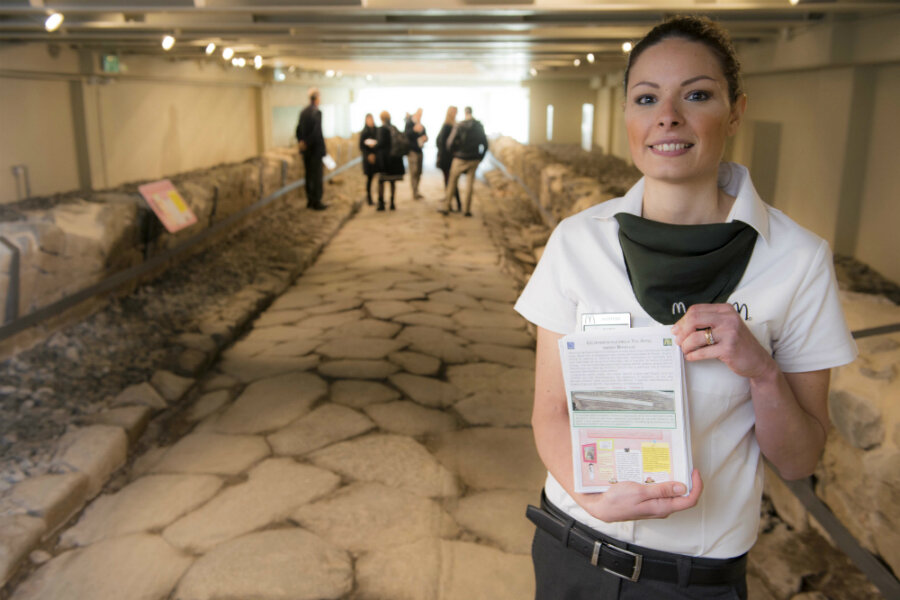Making McHistory? Businesses step up to preserve Rome's antiquities.
Loading...
| Rome
Barely a month goes by in Italy without a major archaeological discovery coming to light. For a country built on the remains of Etruscan ports, Roman cities, and ancient Greek colonies, that is no surprise.
The challenge, though, is what to do with the treasures once they are discovered beneath the ground. Italy is still trying to recover from the global economic crisis and struggles to find the money to look after its 51 World Heritage sites – the most of any country in the world – let alone the thousands of other, lesser-known discoveries.
Enter the private sector. In the past few years, corporations have galloped to the rescue of the country’s cultural heritage, collaborating with the State to restore monuments across the country.
It is partly philanthropy – doing something for the good of the nation – and partly commercial savviness; donating money to valuable heritage sites adds prestige to a company’s corporate image.
Roman drive-thru
In the latest example of public-private cooperation, McDonald’s paid for the preservation of a stretch of ancient Roman road that was found when the fast food giant started excavating a patch of land outside Rome for the building of a new restaurant.
When the 2nd century BC paved road was found during digging for foundations in 2014, archaeologists were immediately notified, as Italian law stipulates. They spent the next two years working at the site, at Frattocchie, south of the capital, stripping back the dirt to reveal a remarkably well-preserved 150-ft-long stretch of road paved with basalt stones.
Had McDonald’s not contributed 300,000 euros ($317,000) to the project, the road might well have been covered up again. It often happens in Italy that, because of a lack of State funds, archaeological sites are reburied, on the principle that they stay protected underground.
But with the money from the burger chain, experts were able to create a mini-museum based around the stretch of road. It lies beneath the new McDonald’s and was inaugurated this week.
A glass floor inside the fast food outlet enables customers to peer down on the Roman road as they munch McNuggets and slurp milkshakes. They can then venture underground to walk along the 2,000-year-old highway. The entrance is open to anyone – you don’t need to have bought a cheeseburger and fries.
The road connected with the Appian Way, one of ancient Rome’s most important thoroughfares, which led from the imperial capital to Brindisi on the Adriatic coast.
“This project is a virtuous example of how the public and private sectors can work together towards restoring cultural heritage for the benefit of the community,” says Mario Federico, the managing director of McDonald’s in Italy. “The project was financed by McDonald's and represents a perfect example of coexistence between modernity and ancient culture.”
Stumping up money to preserve the Roman road was part of the burger chain’s “commitment to be integrated into the territories where we operate.”
Corporate upkeep
The Roman road project was unusual in that it involved a corporation paying for the restoration of a newly discovered cultural heritage site.
Most other public-private collaborations in Italy involve companies getting out their checkbooks to spruce up well-known monuments; the more well-known, the better for their corporate image.
The trend started in 2011 when Tod’s, an Italian firm that makes high-end leather shoes and bags, announced that it would pay 25 million euros ($26.4 million) for the cleaning of the Colosseum, the walls of which had been blackened by years of pollution. Bureaucracy and red tape delayed the project but it finally got underway in 2013.
Financing the project was a demonstration of the company’s “integrity” and its affinity with the workmanship that went into the amphitheater, said Diego Della Valle, Tod’s CEO.
The Tod’s deal spurred other companies to come to the rescue of crumbling, damaged monuments.
They were further encouraged by a generous tax break, introduced by the Italian government in 2014, for companies willing to invest in the cultural heritage sector. Named the “Art Bonus,” it allows companies or individuals to claim a 65 percent tax break on their charitable donations.
Fendi, the fashion house, donated 2.5 million euros for the cleaning and restoration of the Trevi Fountain in Rome, where Anita Ekberg famously flirted with Marcello Mastroianni in "La Dolce Vita," the 1960 Fellini classic.
Then Bulgari, the jewelers, gave 1.5 million euros for the restoration of the famous Spanish Steps in Rome, scene of a memorable encounter between Gregory Peck and Audrey Hepburn in the 1953 romantic comedy "Roman Holiday."
Win-win
Some cultural heritage experts fretted that the firms would exploit their munificence by insisting on plastering their logos all over the monuments.
But that didn’t happen, because the authorities put in place strict regulations on such advertising. On a stroll this week up and down the Spanish Steps, Bulgari’s involvement in the project was barely evident. At the Trevi Fountain, Fendi’s generosity is also discreetly acknowledged, with just a small placard.
Buoyed by these successes, Italy is seeking foreign private money for the restoration of other heritage sites, including the Domus Aurea, a palatial residence in Rome that was built by the Emperor Nero, and a sprawling 18th century palace near Naples which rivaled Versailles.
It seems, so far, to be a win-win situation.
And with the Italian economy growing by less than 1 percent a year, and unemployment stuck at more than 10 percent, there appears to be little choice other than to look to corporations for the salvation of Italy’s unparalleled, but oft-neglected, cultural heritage.








